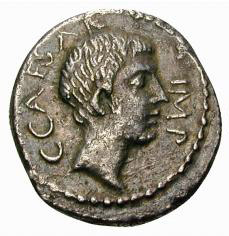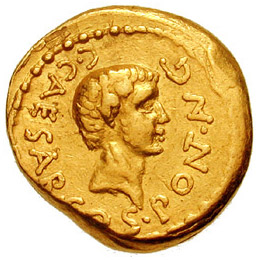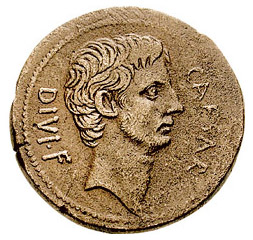Rival Claims: Octavian and Caesar
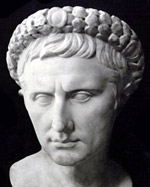
The death of Caesar brought his heir Octavian into direct opposition to Antony; both presented themselves as Caesar's political successor. Octavian, as Caesar's legal heir, could claim not only Caesar's name but a familial bond and this becomes a common motif in his coinage throughout the Triumviral period. He first minted coinage in 43 BC during campaigns in Gaul (RRC 490/1-4). Octavian chose a similar type to that of Antony, a double portrait coin. This issue (RRC 490/2), which emphasises his kinship with Caesar, is the first produced in gold since Caesar's death. The obverse depicts the young Octavian bearded, as a sign of mourning. The reverse carries a laureate portrait of Caesar. The similarity in portrait style is designed to closely link the men. The legends too aid in this purpose. The obverse reads C CAESAR COS PONT AVG (Gaius Caesar, Consul, Pontifex, Augur) and the reverse C CAESAR DICT PERP PONT MAX. (Gaius Caesar, Dictator for Life, Pontifex Maximus).
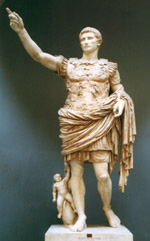
The second type created by Octavian at this time (43 BC) emphasises his own valour. As a young man he lacked the military reputation of other commanders, important to securing the support of Caesar's veteran army. RRC 490/1 illustrates a bearded portrait of Octavian on the obverse, combined with an equestrian statue on the reverse. The statue was erected in Octavian's honour by the senate (Vell. ii.61.3), and something alluded to by the use of the legend SC (senatus consultum) (Zanker 1988:38). The statue represented his victories at the Forum Gallorum and Mutina and arguably presented a promising image of the victorious general. This is the first of three similar statues represented on his coinage. Two others (RRC 497/1 and 518/2) appear in the next few years and are probably stylised versions of the first.
The formation of the Triumviri Rei Publicae Constituendae provided Octavian with a legitimate legal position of power. He appears in double portrait issues with Antony and Lepidus (RRC 492/1 and 493). The issues of the Quattuorviri Monetales of 42 BC highlight his link to Caesar and Venus through a coin (RRC 494/3) with Octavian's portrait on the obverse, and Aeneas carrying Anchises on his shoulder on the reverse.
The coinage of Octavian himself in 42 BC continued to propagate images of Caesar and martial valour. RRC 497/2 highlights Caesar as dictator for life. RRC 497/3 carries the traditional Roman imagery of war and victory: the obverse depicted Mars and the reverse an aquila (the main standard of a legion) surmounted by a trophy and flanked by two standards which symbolised the power embodied in the legions and its commander.
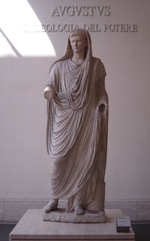
From ca. 38 BC Octavian began to emphasise the divinity of Caesar on his coinage. He uses the term DIVI IVLI F (son of the divine Julius) to emphasise the link between Caesar's divinity and himself. He adopts this title in many of his subsequent issues, even after the defeat of Antony at Actium. RRC 535/1 depicts Octavian on the obverse with the legend CAESAR before and DIVI F behind, while the reverse shows a wreathed portrait of Caesar with the title DIVOS IVLIVS. Octavian successfully paired his portrait with that of Caesar throughout this period advertising continually the strong links between himself and the deceased dictator, links which could not be surmounted, even by Antony.

